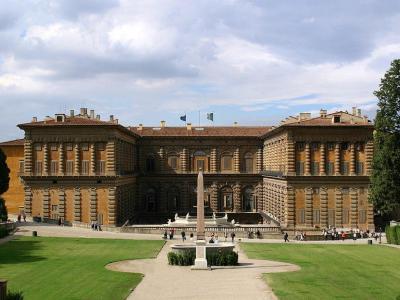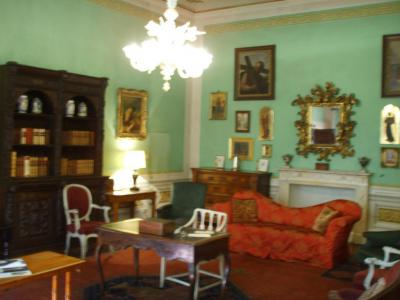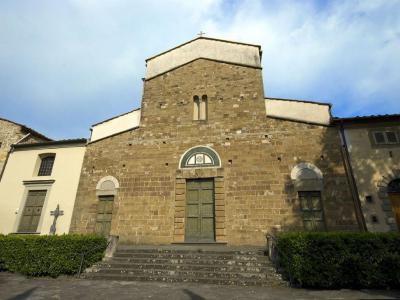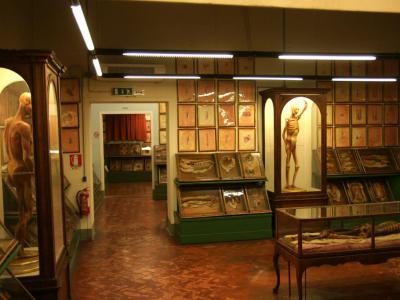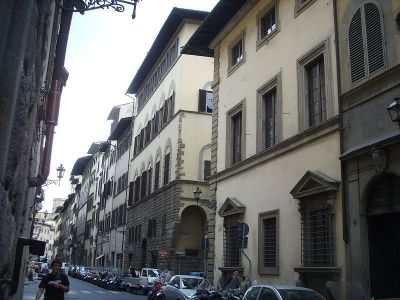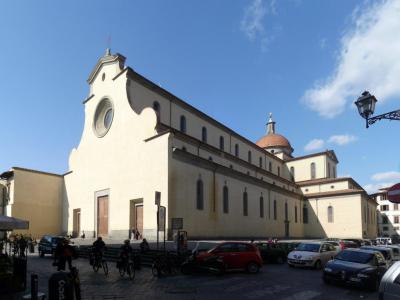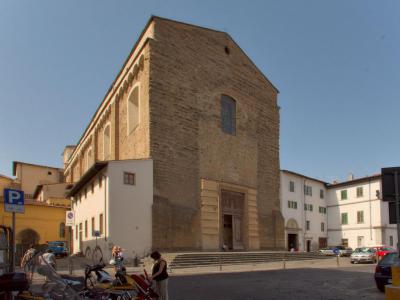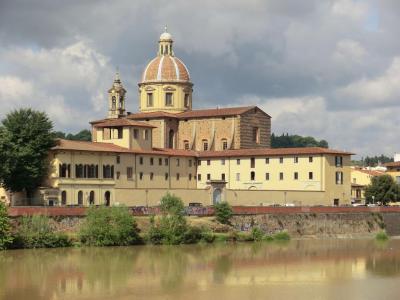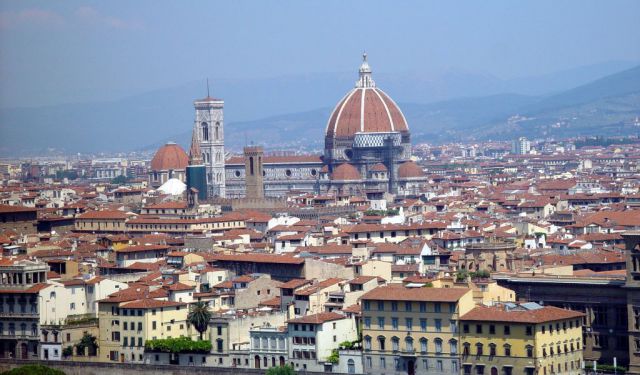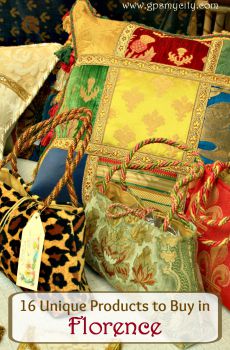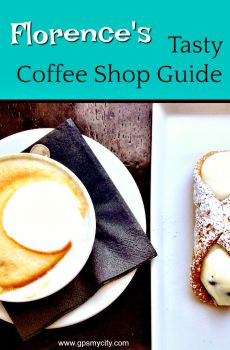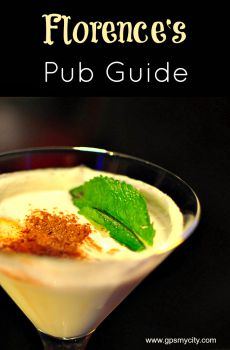
Arno South Bank Walking Tour (Self Guided), Florence
The area south of the Arno River—known as Oltrarno, or “Beyond the Arno”—offers a quieter, more intimate side of Florence, but one that’s no less captivating. It’s here that you’ll find the grand Pitti Palace, home to a painting collection rivaled only by the Uffizi Gallery, and the expansive Boboli Gardens, once the private domain of the Medici and later, the royal family. As one of the earliest and most influential examples of Italian garden design, Boboli went on to inspire courtly landscapes all across Europe.
Oltrarno is steeped in tradition, known for its artisans, age-old trades, and vibrant markets. The best way to experience it? On foot. Wander its cobbled streets and you’ll uncover workshops, tucked-away trattorias, graceful piazzas, and churches that are true masterpieces in their own right.
This part of the city is steeped in old-world tradition, known for its skilled artisans and age-old trade. It’s best explored slowly—on foot—so you can appreciate the local craftsmanship, bustling markets, and family-run trattorias, as well as the intimate charm of hidden squares, quiet corners, and a wealth of sacred spaces.
Right from the get-go, the main attraction of Santa Felicita’s Church is Pontormo’s stunning “Deposition from the Cross”, recently restored to vivid glory. Above the entrance, look for the enclosed balcony of the Vasari Corridor—built for the Medici to move unseen between palace and government.
A short walk away, the Basilica of the Holy Spirit invites you inside to admire Michelangelo’s rare wooden sculpture of a nude Christ on the Cross. Don’t miss the serene 17th-century cloister and its tranquil garden, framed by elegant arcades.
Toward the end of your walk, pause at the Church of Our Lady of Mount Carmel, where frescoes by Masolino and Masaccio mark a turning point in Renaissance art. Then, step into the Church of Saint Fridianus, a standout example of late Baroque in Florence, where Roman grandeur meets Tuscan restraint. It’s also a lovely backdrop for a photo or a quiet moment.
This self-guided tour leads you through all these treasures and more, winding past cobbled lanes, historic palaces, and artisan workshops. Take your time, wear comfortable shoes, and let the Oltrarno unfold at your own rhythm.
Oltrarno is steeped in tradition, known for its artisans, age-old trades, and vibrant markets. The best way to experience it? On foot. Wander its cobbled streets and you’ll uncover workshops, tucked-away trattorias, graceful piazzas, and churches that are true masterpieces in their own right.
This part of the city is steeped in old-world tradition, known for its skilled artisans and age-old trade. It’s best explored slowly—on foot—so you can appreciate the local craftsmanship, bustling markets, and family-run trattorias, as well as the intimate charm of hidden squares, quiet corners, and a wealth of sacred spaces.
Right from the get-go, the main attraction of Santa Felicita’s Church is Pontormo’s stunning “Deposition from the Cross”, recently restored to vivid glory. Above the entrance, look for the enclosed balcony of the Vasari Corridor—built for the Medici to move unseen between palace and government.
A short walk away, the Basilica of the Holy Spirit invites you inside to admire Michelangelo’s rare wooden sculpture of a nude Christ on the Cross. Don’t miss the serene 17th-century cloister and its tranquil garden, framed by elegant arcades.
Toward the end of your walk, pause at the Church of Our Lady of Mount Carmel, where frescoes by Masolino and Masaccio mark a turning point in Renaissance art. Then, step into the Church of Saint Fridianus, a standout example of late Baroque in Florence, where Roman grandeur meets Tuscan restraint. It’s also a lovely backdrop for a photo or a quiet moment.
This self-guided tour leads you through all these treasures and more, winding past cobbled lanes, historic palaces, and artisan workshops. Take your time, wear comfortable shoes, and let the Oltrarno unfold at your own rhythm.
How it works: Download the app "GPSmyCity: Walks in 1K+ Cities" from Apple App Store or Google Play Store to your mobile phone or tablet. The app turns your mobile device into a personal tour guide and its built-in GPS navigation functions guide you from one tour stop to next. The app works offline, so no data plan is needed when traveling abroad.
Arno South Bank Walking Tour Map












Guide Name: Arno South Bank Walking Tour
Guide Location: Italy » Florence (See other walking tours in Florence)
Guide Type: Self-guided Walking Tour (Sightseeing)
# of Attractions: 11
Tour Duration: 2 Hour(s)
Travel Distance: 2.4 Km or 1.5 Miles
Author: greghasleft
Sight(s) Featured in This Guide:
Guide Location: Italy » Florence (See other walking tours in Florence)
Guide Type: Self-guided Walking Tour (Sightseeing)
# of Attractions: 11
Tour Duration: 2 Hour(s)
Travel Distance: 2.4 Km or 1.5 Miles
Author: greghasleft
Sight(s) Featured in This Guide:
- Ponte Vecchio (Old Bridge)
- Chiesa di Santa Felicita (Church of St. Felicity)
- Palazzo Pitti (Pitti Palace)
- Casa Guidi (Home of Robert and Elizabeth Barrett Browning)
- Chiesa di San Felice in Piazza (Church of St. Felix)
- Museo Storia Naturale - La Specola (Museum of Natural History)
- Via Maggio (broadest street in Florence)
- Basilica di Santo Spirito (Basilica of the Holy Spirit)
- Basilica di Santa Maria del Carmine (Basilica of Our Lady of Mount Carmel)
- Chiesa di San Frediano in Cestello (Church of Saint Fridianus)
- Porta San Frediano (San Frediano Gate)
1) Ponte Vecchio (Old Bridge) (must see)
Ponte Vecchio, or The Old Bridge, first appeared in written records all the way back in 996. Of the six bridges that span the Arno River in Florence, it’s the only one that survived World War II intact—spared by retreating German forces. Today, this medieval stone arch structure stands as a powerful reminder of how a ruler’s vision can shape a city’s legacy.
As in the Middle Ages, the bridge is still lined with shops—but what’s sold here has changed quite a bit over time. Originally, it was occupied by butchers, who were know for tossing animal waste directly into the river—hardly ideal for anyone strolling by. That all changed in the 16th century, when Grand Duke Ferdinando de’ Medici had the meat merchants removed and replaced with goldsmiths. Not only did this improve the smell, but it also turned the bridge into one of the most glittering, upscale corners of Florence.
Take a look from a distance, and you might spot something unusual—a raised corridor running above the shops. This hidden passage is part of the Vasari Corridor, a nearly kilometer-long tunnel that connects the Pitti Palace with the Old Palace. It was built so that the Grand Duke could move between his residence and government offices without mingling with the crowds. Although closed since 2016 for safety reasons, there are plans to reopen it for visitors.
There’s even a bit of financial folklore tied to this spot, which is said to be the birthplace of the term “bankruptcy.” When a moneylender couldn’t pay his debts, soldiers smashed his trading bench—called a banco—to pieces, a symbolic act that left him unable to operate. Hence the term “bancorotto”, or “broken bench”, was born.
These days, the Old Bridge is a lovely place for a walk—especially at sunset, when the light casts a golden glow over the Arno. Early mornings are just as magical, with soft reflections on the water and, if you’re lucky, the bridge nearly all to yourself.
As in the Middle Ages, the bridge is still lined with shops—but what’s sold here has changed quite a bit over time. Originally, it was occupied by butchers, who were know for tossing animal waste directly into the river—hardly ideal for anyone strolling by. That all changed in the 16th century, when Grand Duke Ferdinando de’ Medici had the meat merchants removed and replaced with goldsmiths. Not only did this improve the smell, but it also turned the bridge into one of the most glittering, upscale corners of Florence.
Take a look from a distance, and you might spot something unusual—a raised corridor running above the shops. This hidden passage is part of the Vasari Corridor, a nearly kilometer-long tunnel that connects the Pitti Palace with the Old Palace. It was built so that the Grand Duke could move between his residence and government offices without mingling with the crowds. Although closed since 2016 for safety reasons, there are plans to reopen it for visitors.
There’s even a bit of financial folklore tied to this spot, which is said to be the birthplace of the term “bankruptcy.” When a moneylender couldn’t pay his debts, soldiers smashed his trading bench—called a banco—to pieces, a symbolic act that left him unable to operate. Hence the term “bancorotto”, or “broken bench”, was born.
These days, the Old Bridge is a lovely place for a walk—especially at sunset, when the light casts a golden glow over the Arno. Early mornings are just as magical, with soft reflections on the water and, if you’re lucky, the bridge nearly all to yourself.
2) Chiesa di Santa Felicita (Church of St. Felicity)
Dedicated to Saint Felicity, an early Roman martyr, this is one of the oldest churches in Florence—founded as early as the 2nd century AD by Greek or Syrian merchants, who were among the city’s first Christians. A Romanesque version was built in the 11th century, but the structure we see today dates from the 1730s, redesigned as a single-nave sanctuary.
Santa Felicita lies directly along the route of the Vasari Corridor—the secret passage used by the Medici family to move between the Old Palace and their residence at the Pitti Palace. From a high balcony at the back of the church, the Medici could attend mass discreetly, without mingling with the general public.
What truly draws visitors today, though, is the remarkable artwork inside, starting with Jacopo Pontormo’s “Deposition from the Cross”, painted between 1525 and 1528. Pontormo, a key figure of the early Florentine Renaissance and a contemporary of Michelangelo, created a work that breaks from tradition in every sense. There’s no cross, no background scenery, and almost no ground beneath the figures. Christ’s body is carried by ethereal, almost floating figures, surrounded by swirling drapery in rich, luminous colors. The only hint of the setting is a pale, ghostlike cloud in the background. And look closely—the man in the corner with the cloak and beard is believed to be Pontormo himself, quietly observing the scene he created.
It’s one of the most emotionally charged and visually stunning depictions of the Passion you’ll find in Florence—well worth stepping inside to experience firsthand.
Santa Felicita lies directly along the route of the Vasari Corridor—the secret passage used by the Medici family to move between the Old Palace and their residence at the Pitti Palace. From a high balcony at the back of the church, the Medici could attend mass discreetly, without mingling with the general public.
What truly draws visitors today, though, is the remarkable artwork inside, starting with Jacopo Pontormo’s “Deposition from the Cross”, painted between 1525 and 1528. Pontormo, a key figure of the early Florentine Renaissance and a contemporary of Michelangelo, created a work that breaks from tradition in every sense. There’s no cross, no background scenery, and almost no ground beneath the figures. Christ’s body is carried by ethereal, almost floating figures, surrounded by swirling drapery in rich, luminous colors. The only hint of the setting is a pale, ghostlike cloud in the background. And look closely—the man in the corner with the cloak and beard is believed to be Pontormo himself, quietly observing the scene he created.
It’s one of the most emotionally charged and visually stunning depictions of the Passion you’ll find in Florence—well worth stepping inside to experience firsthand.
3) Palazzo Pitti (Pitti Palace) (must see)
The Pitti Palace is one of Florence’s grandest landmarks—missing it would be like skipping a chapter in the city’s history. This massive 15th-century residence is a celebration of Renaissance architecture, and its vast gardens, full of winding paths and hidden corners, offer a new surprise with every turn.
Originally built for the powerful Medici family, the palace served as their official residence from the 16th to the 18th century. After the Medici dynasty ended, the property passed to the House of Lorraine, and later, Napoleon Bonaparte used it as a stronghold during his rule over Italy. Today, the palace houses a remarkable collection of museums— yet, it still holds what may be the richest concentration of Medici art and history. Alongside priceless paintings are beautifully preserved furnishings and interior details that once belonged to the family.
Every part of the palace reflects elegance and power—from the Palatine Gallery, with over 500 Renaissance paintings, to the opulent Royal Apartments, the glittering Medici Treasury, and the Gallery of Costume and Fashion. You’ll also find specialized museums showcasing porcelain and royal carriages, offering a different glimpse into court life.
In short, although it’s been state property since 1919, the palace still carries the atmosphere of a private royal home. And with over 5 million visitors each year, it remains one of Florence’s most admired cultural spots.
Tip: A combo ticket gives you access to both the museums and the gardens for two full days—plenty of time to explore at a relaxed pace. If you plan to spend a few hours in the gardens, don’t forget a hat and water, especially in warmer months. To avoid waiting in long lines at the entrance, booking a guided tour is a smart move. Yes, there's an added cost, but you'll skip the queue and get deeper insights into this piece of Florentine history.
Originally built for the powerful Medici family, the palace served as their official residence from the 16th to the 18th century. After the Medici dynasty ended, the property passed to the House of Lorraine, and later, Napoleon Bonaparte used it as a stronghold during his rule over Italy. Today, the palace houses a remarkable collection of museums— yet, it still holds what may be the richest concentration of Medici art and history. Alongside priceless paintings are beautifully preserved furnishings and interior details that once belonged to the family.
Every part of the palace reflects elegance and power—from the Palatine Gallery, with over 500 Renaissance paintings, to the opulent Royal Apartments, the glittering Medici Treasury, and the Gallery of Costume and Fashion. You’ll also find specialized museums showcasing porcelain and royal carriages, offering a different glimpse into court life.
In short, although it’s been state property since 1919, the palace still carries the atmosphere of a private royal home. And with over 5 million visitors each year, it remains one of Florence’s most admired cultural spots.
Tip: A combo ticket gives you access to both the museums and the gardens for two full days—plenty of time to explore at a relaxed pace. If you plan to spend a few hours in the gardens, don’t forget a hat and water, especially in warmer months. To avoid waiting in long lines at the entrance, booking a guided tour is a smart move. Yes, there's an added cost, but you'll skip the queue and get deeper insights into this piece of Florentine history.
4) Casa Guidi (Home of Robert and Elizabeth Barrett Browning)
Tucked just around the corner from the Pitti Palace, Casa Guidi is a suite of eight rooms that once belonged to one of literature’s most celebrated couples—Robert and Elizabeth Barrett Browning. Housed in a 15th-century palace, the property became a hub of British life in Florence. Originally two separate medieval structures, it was combined and renovated in the late 1700s, then found new life when the Brownings moved in after their secret marriage in 1847. Shortly after the birth of their son Pen, Elizabeth began calling the apartment “Casa Guidi”, turning what she described as “a mere palace into a home.”
The couple traveled often, collecting furniture and art from across Europe, and slowly filled the place with warmth and meaning. It was here that Elizabeth composed much of her poetry, including the “Casa Guidi Windows” collection, which reflects her deep engagement with the political changes sweeping through Italy at the time.
Fortunately, the Browning Society of New York restored the old apartment, and in 1993, after approvals from authorities in Italy, the UK, and the US, ownership was officially transferred to Eton College. Today, for a small donation, you can step inside and see the place much as it looked when the Brownings called it home: spacious, filled with charm, and rich with literary history. Just ring the bell and you’ll be let in—no stairs required, there’s an elevator too.
The couple traveled often, collecting furniture and art from across Europe, and slowly filled the place with warmth and meaning. It was here that Elizabeth composed much of her poetry, including the “Casa Guidi Windows” collection, which reflects her deep engagement with the political changes sweeping through Italy at the time.
Fortunately, the Browning Society of New York restored the old apartment, and in 1993, after approvals from authorities in Italy, the UK, and the US, ownership was officially transferred to Eton College. Today, for a small donation, you can step inside and see the place much as it looked when the Brownings called it home: spacious, filled with charm, and rich with literary history. Just ring the bell and you’ll be let in—no stairs required, there’s an elevator too.
5) Chiesa di San Felice in Piazza (Church of St. Felix)
Just west of the Pitti Palace, on the southern bank of the Arno, stands one of Florence’s lesser-known but oldest churches—dating all the way back to 1066. While the Gothic interior holds onto its medieval spirit, the Renaissance-style façade is credited to Michelozzo, a trusted architect of the Medici.
In 1153, the Benedictines took over and by the mid-14th century, began expanding the structure. That’s when the pointed single-lancet windows were added—still visible along the outer wall. Around the same time, a lunette fresco appeared on the sixth altar on the left, portraying the Madonna and Child, Saint James the Greater, Pope Sylvester, and the abbot of Nonantola, who also happened to commission the piece.
Wander through the side aisles, and you’ll come across an amazing mini-gallery of Renaissance and Mannerist works. Among these are the “Apparition of the Madonna to Saint Hyacinth” and “Saunt Peter Martyr” by Empoli, or a charming “Madonna and Child” from the early 1400s. There’s also the striking polychrome terracotta “Deposition”, the “Madonna and Saints” by Ridolfo del Ghirlandaio, and “Madonna della Cintola and Saints”, a fresco by Bicci di Lorenzo. The 17th-century side chapels bring even more into the mix, including a vivid “Last Supper”, rescued from the now-destroyed monastery of San Pietro Martire.
It may not grab headlines like the Duomo or the Holy Cross Basilica, but this unassuming church quietly packs a punch. With centuries of history etched into its stones and masterworks tucked behind its altars, it’s a true hidden treasire—and you won’t even need a ticket to walk through its doors.
In 1153, the Benedictines took over and by the mid-14th century, began expanding the structure. That’s when the pointed single-lancet windows were added—still visible along the outer wall. Around the same time, a lunette fresco appeared on the sixth altar on the left, portraying the Madonna and Child, Saint James the Greater, Pope Sylvester, and the abbot of Nonantola, who also happened to commission the piece.
Wander through the side aisles, and you’ll come across an amazing mini-gallery of Renaissance and Mannerist works. Among these are the “Apparition of the Madonna to Saint Hyacinth” and “Saunt Peter Martyr” by Empoli, or a charming “Madonna and Child” from the early 1400s. There’s also the striking polychrome terracotta “Deposition”, the “Madonna and Saints” by Ridolfo del Ghirlandaio, and “Madonna della Cintola and Saints”, a fresco by Bicci di Lorenzo. The 17th-century side chapels bring even more into the mix, including a vivid “Last Supper”, rescued from the now-destroyed monastery of San Pietro Martire.
It may not grab headlines like the Duomo or the Holy Cross Basilica, but this unassuming church quietly packs a punch. With centuries of history etched into its stones and masterworks tucked behind its altars, it’s a true hidden treasire—and you won’t even need a ticket to walk through its doors.
6) Museo Storia Naturale - La Specola (Museum of Natural History)
Amidst Florence’s historic churches and grand palaces lies a place that feels like a beautifully organized cabinet of curiosity—La Specola, one of Europe’s oldest science museums. Dedicated to Zoology and Natural History, it was founded in 1775 by Grand Duke Pietro Leopoldo di Lorena, who imagined a space where science could be admired by everyone, not just scholars. To make that vision real, he bought a block of buildings near the Pitti Palace and opened the doors to the public. And not just symbolically—this was the world’s first scientific museum with regular hours, guided tours, and actual curators. Fittingly, the walls are adorned with frescoes and finely cut stones that celebrate Italy’s greatest scientific milestones, from the Renaissance all the way into the Enlightenment.
Spread across 34 rooms, the museum's collection is vast and varied. You’ll encounter fossils, minerals, exotic animals, rare plants, and even first-edition scientific books. Many items date back to the 14th and 15th centuries, reflecting the the collecting habits of the Medici family, who once sourced treasures from around the globe.
But the real showstopper here is the world-famous collection of anatomical wax models. Introduced as an alternative to cadaver dissections, these lifelike creations were groundbreaking in both science and art. Crafted with astonishing precision and realism, they are both beautiful and bizarre, having earned La Specola international fame.
So if your feet need a break from Renaissance artworks, come indulge your inner curious kid—or mad scientist. Florence may be known for Botticelli and Brunelleschi, but here, the stars of the show have feathers, fangs, and a very lifelike circulatory system. Entry is modest, the crowds are manageable, and the conversation starters—endless.
Spread across 34 rooms, the museum's collection is vast and varied. You’ll encounter fossils, minerals, exotic animals, rare plants, and even first-edition scientific books. Many items date back to the 14th and 15th centuries, reflecting the the collecting habits of the Medici family, who once sourced treasures from around the globe.
But the real showstopper here is the world-famous collection of anatomical wax models. Introduced as an alternative to cadaver dissections, these lifelike creations were groundbreaking in both science and art. Crafted with astonishing precision and realism, they are both beautiful and bizarre, having earned La Specola international fame.
So if your feet need a break from Renaissance artworks, come indulge your inner curious kid—or mad scientist. Florence may be known for Botticelli and Brunelleschi, but here, the stars of the show have feathers, fangs, and a very lifelike circulatory system. Entry is modest, the crowds are manageable, and the conversation starters—endless.
7) Via Maggio (broadest street in Florence)
Via Maggio is one of the most elegant and historically layered streets in Florence, nestled in the Oltrarno district. Its roots stretch back to the Renaissance, when it was known as Via Maggiore, or “Broad Street”—a name reflecting both its stature and literal broadness. Once a prestigious address for nobles and diplomats, it still carries an air of refinement. Grand palaces from the 15th and 16th centuries line the road, many now housing antique shops, galleries, and stylish boutiques. It's a perfect destination for anyone drawn to Florence’s artistic soul and aristocratic past.
The street truly flourished during the Medici era, especially after the court settled into the nearby Pitti Palace. Wanting to stay close to influence and wealth, Florence’s elite built sumptuous residences here. Among the most notable is the Bianca Cappello Palace, named after the Venetian noblewoman who rose from mistress to Grand Duchess as the wife of Francesco de’ Medici. Its façade, richly adorned with sgraffito, still catches the eye today.
Walking here feels like stepping through a living museum. Window displays often rival those in museums, showcasing everything from oil paintings to vintage furniture, marble sculptures, tapestries, and even antique weaponry. For those with a taste for the contemporary, several modern galleries add fresh energy with rotating exhibitions by both Italian and international artists.
When you’re ready to rest, you’ll also find cozy cafés, stylish trattorias, and intimate wine bars lining the street. Sit back with a glass of Chianti or a rich espresso and let the Oltrarno atmosphere work its quiet magic.
The street truly flourished during the Medici era, especially after the court settled into the nearby Pitti Palace. Wanting to stay close to influence and wealth, Florence’s elite built sumptuous residences here. Among the most notable is the Bianca Cappello Palace, named after the Venetian noblewoman who rose from mistress to Grand Duchess as the wife of Francesco de’ Medici. Its façade, richly adorned with sgraffito, still catches the eye today.
Walking here feels like stepping through a living museum. Window displays often rival those in museums, showcasing everything from oil paintings to vintage furniture, marble sculptures, tapestries, and even antique weaponry. For those with a taste for the contemporary, several modern galleries add fresh energy with rotating exhibitions by both Italian and international artists.
When you’re ready to rest, you’ll also find cozy cafés, stylish trattorias, and intimate wine bars lining the street. Sit back with a glass of Chianti or a rich espresso and let the Oltrarno atmosphere work its quiet magic.
8) Basilica di Santo Spirito (Basilica of the Holy Spirit)
Here we have yet another Florence landmark linked to the brilliant Renaissance architect—Filippo Brunelleschi. At first glance, the plain façade may not look too impressive, but step inside, and the story changes completely. The interior reveals a plethora of Baroque embellishments, crowned by a colorful Baldachin above the elevated altar. Along the entire perimeter, forty uniform side chapels—set like niches—house a remarkable collection of Renaissance art, featuring works by masters like Sansovino and Rosselli. Some of the restored pieces are especially vivid, with colors and detail that practically leap from the walls.
For a small fee, you can explore the two cloisters, where the walls are lined with historic tombstones and impressive Late Gothic frescoes. You’ll also find sculptures spanning the 11th to 15th centuries, including low reliefs by Donatello, a high relief of the Madonna and Child, and two graceful marble figures carved by Tino da Camaino in the early 1300s.
Tucked away in a side chapel is a very special find—the wooden crucifix carved by a young Michelangelo, long before he made his mark in Rome. Just seventeen at the time, he was granted permission to study anatomy using cadavers from the convent’s hospital. In return, he created this delicate crucifix, initially placed above the high altar. Today, it resides in the octagonal sacristy, which you can reach from the church’s western aisle. While you're there, take a moment to admire faithful reproductions of his later works—“Pietà” and “Christ”—both remarkable in their own right.
Tip: Don’t leave without stopping by the Salvatore Romano Foundation, located in the old refectory beside the basilica, now home to a nicely curated collection of ancient art.
For a small fee, you can explore the two cloisters, where the walls are lined with historic tombstones and impressive Late Gothic frescoes. You’ll also find sculptures spanning the 11th to 15th centuries, including low reliefs by Donatello, a high relief of the Madonna and Child, and two graceful marble figures carved by Tino da Camaino in the early 1300s.
Tucked away in a side chapel is a very special find—the wooden crucifix carved by a young Michelangelo, long before he made his mark in Rome. Just seventeen at the time, he was granted permission to study anatomy using cadavers from the convent’s hospital. In return, he created this delicate crucifix, initially placed above the high altar. Today, it resides in the octagonal sacristy, which you can reach from the church’s western aisle. While you're there, take a moment to admire faithful reproductions of his later works—“Pietà” and “Christ”—both remarkable in their own right.
Tip: Don’t leave without stopping by the Salvatore Romano Foundation, located in the old refectory beside the basilica, now home to a nicely curated collection of ancient art.
9) Basilica di Santa Maria del Carmine (Basilica of Our Lady of Mount Carmel)
This is a place of devotion dedicated to Our Lady of Mount Carmel, a revered title for the Virgin Mary. First built in the late 13th century, the building’s surviving Romanesque-Gothic exterior offers a glimpse into its medieval origins. But the church’s story took a dramatic turn in the 1700s when a fire ravaged through, sparing only one section: the now-famous Brancacci Chapel.
That chapel is one of the cornerstones of early Renaissance art. Work began in 1425, when Masolino da Panicale was commissioned to paint its walls. He soon brought in a young apprentice, Masaccio, just 21 years old at the time. Masaccio’s contributions turned out to be groundbreaking—his naturalistic figures and bold use of perspective would shape the future of Western painting. Sadly, he died just three years later, leaving the work incomplete. The frescoes remained unfinished until decades later, when Filippino Lippi added his own touch, completing the chapel in harmony with Masaccio’s vision.
Another notable part of the church is the Corsini Chapel, created for one of Florence’s most prominent families during the 17th and 18th centuries. It was built in 1675 to house the remains of Andrea Corsini, a nobleman-turned-Carmelite friar and Bishop of Fiesole, who was later canonized. The chapel is a textbook example of Florentine Baroque, and features a lovely dome frescoed in 1682. Look up, and you’ll see the ceiling brought to life by Giovanni Domenico Ferretti—his Rococo style adds a dramatic flair that still stands out centuries later.
That chapel is one of the cornerstones of early Renaissance art. Work began in 1425, when Masolino da Panicale was commissioned to paint its walls. He soon brought in a young apprentice, Masaccio, just 21 years old at the time. Masaccio’s contributions turned out to be groundbreaking—his naturalistic figures and bold use of perspective would shape the future of Western painting. Sadly, he died just three years later, leaving the work incomplete. The frescoes remained unfinished until decades later, when Filippino Lippi added his own touch, completing the chapel in harmony with Masaccio’s vision.
Another notable part of the church is the Corsini Chapel, created for one of Florence’s most prominent families during the 17th and 18th centuries. It was built in 1675 to house the remains of Andrea Corsini, a nobleman-turned-Carmelite friar and Bishop of Fiesole, who was later canonized. The chapel is a textbook example of Florentine Baroque, and features a lovely dome frescoed in 1682. Look up, and you’ll see the ceiling brought to life by Giovanni Domenico Ferretti—his Rococo style adds a dramatic flair that still stands out centuries later.
10) Chiesa di San Frediano in Cestello (Church of Saint Fridianus)
Take a slow wander through the lesser-known corners of Florence—the kind of neighborhoods most tourists breeze past. One such area is San Frediano. It may not flaunt headline landmarks, but what it offers instead is authenticity—a place where you can soak in the rhythm of local life. Just beyond the wide-open Carmine Square lies Borgo San Frediano, a main thoroughfare that still carries the soul of its working-class roots.
Strolling along, you’ll come across a church that seems to rise quietly from the past. Built in the 1680s on the grounds of a former Carmelite convent, it honors Saint Fridianus, an Irish pilgrim who became bishop of Lucca. The name “Cestello” refers to the Cistercian monks who later settled in the adjoining monastery.
From the outside, the rough stone façade may appear unassuming, but step through the doors and you’re met with one of Florence’s most refined Baroque interiors. The space unfolds in graceful symmetry, framed by richly adorned chapels and crowned by a soaring dome. Look up to see Antonio Gabbiani’s frescoes above the main altar—his dramatic, sky-bound scenes pulse with the spiritual energy typical of the late Baroque. While there, also keep an eye out for the much-admired 14th-century “Madonna of the Smile,” along with Poccetti’s “Last Supper,” tucked away in the old refectory.
And if your feet need a break or your sweet tooth stirs, you're in the right neighborhood. San Frediano is home to some of the city’s best eats. Stop by Gelateria La Carraia for a scoop of their daily-made gelato. If cheesecake flavor is on the menu, don’t think twice. Just order it. And maybe order it again.
Strolling along, you’ll come across a church that seems to rise quietly from the past. Built in the 1680s on the grounds of a former Carmelite convent, it honors Saint Fridianus, an Irish pilgrim who became bishop of Lucca. The name “Cestello” refers to the Cistercian monks who later settled in the adjoining monastery.
From the outside, the rough stone façade may appear unassuming, but step through the doors and you’re met with one of Florence’s most refined Baroque interiors. The space unfolds in graceful symmetry, framed by richly adorned chapels and crowned by a soaring dome. Look up to see Antonio Gabbiani’s frescoes above the main altar—his dramatic, sky-bound scenes pulse with the spiritual energy typical of the late Baroque. While there, also keep an eye out for the much-admired 14th-century “Madonna of the Smile,” along with Poccetti’s “Last Supper,” tucked away in the old refectory.
And if your feet need a break or your sweet tooth stirs, you're in the right neighborhood. San Frediano is home to some of the city’s best eats. Stop by Gelateria La Carraia for a scoop of their daily-made gelato. If cheesecake flavor is on the menu, don’t think twice. Just order it. And maybe order it again.
11) Porta San Frediano (San Frediano Gate)
Take a moment to admire one of Florence’s best-preserved medieval gates, standing at the western end of Borgo San Frediano—the main artery of the neighborhood that still pulses with local life. Completed in 1332, this gateway offers a vivid reminder of the city’s fortified past and is among the finest remnants of the 14th-century walls that once enclosed Florence.
Its origins go back even further, to the 12th century, when it served as an important entry point for merchants and travelers arriving from Pisa and the western reaches of Tuscany. The gate is a sturdy example of medieval military design, featuring a grand central arch for carts and horses, flanked by two smaller arches for foot traffic. Above these an overhanging structure with openings was used for dropping stones or boiling liquids on would-be invaders.
As the city grew and the walls were gradually dismantled in the 1800s, many of Florence's old gates were torn down—but not this one. Still bearings its original heavy wooden doors, it stands as quiet witnesses to centuries of change
Tip: If all this walking has worked up an appetite, reward yourself with a stop at Trattoria Sabatino—a no-frills local favorite just outside the gate on Via Pisana 2R. Since 1956, this bright, welcoming dining hall has served affordable, soul-satisfying Tuscan dishes to generations of Florentines. The menu is short, the prices modest, and the atmosphere refreshingly genuine. Perfect for ending a stroll through the Oltrarno with a plate of something comforting and real.
Its origins go back even further, to the 12th century, when it served as an important entry point for merchants and travelers arriving from Pisa and the western reaches of Tuscany. The gate is a sturdy example of medieval military design, featuring a grand central arch for carts and horses, flanked by two smaller arches for foot traffic. Above these an overhanging structure with openings was used for dropping stones or boiling liquids on would-be invaders.
As the city grew and the walls were gradually dismantled in the 1800s, many of Florence's old gates were torn down—but not this one. Still bearings its original heavy wooden doors, it stands as quiet witnesses to centuries of change
Tip: If all this walking has worked up an appetite, reward yourself with a stop at Trattoria Sabatino—a no-frills local favorite just outside the gate on Via Pisana 2R. Since 1956, this bright, welcoming dining hall has served affordable, soul-satisfying Tuscan dishes to generations of Florentines. The menu is short, the prices modest, and the atmosphere refreshingly genuine. Perfect for ending a stroll through the Oltrarno with a plate of something comforting and real.
Walking Tours in Florence, Italy
Create Your Own Walk in Florence
Creating your own self-guided walk in Florence is easy and fun. Choose the city attractions that you want to see and a walk route map will be created just for you. You can even set your hotel as the start point of the walk.
Florence's Hidden Art Treasures
The “Cradle of the Renaissance,” Florence is one of Europe’s most beautiful and busiest destinations, home to some of the world's greatest pieces of art and architecture. The iconic masters like Giotto, Botticelli, Raphael and Michelangelo, as well as their somewhat less-known but equally talented counterparts, such as Ghirlandaio, Sangallo and Castagno, have blessed this city with... view more
Tour Duration: 2 Hour(s)
Travel Distance: 3.2 Km or 2 Miles
Tour Duration: 2 Hour(s)
Travel Distance: 3.2 Km or 2 Miles
Florence Introduction Walking Tour
Florence was founded in 59 BC by Julius Caesar as a settlement for his veteran soldiers. Laid out like a Roman military camp, its main roads intersected at what is now the Republic Square. Originally named Fluentia, referencing its location between two rivers, the city later adopted the name Florentia, meaning “flowering” or “flourishing”.
And flourish it did. During the Middle Ages and... view more
Tour Duration: 2 Hour(s)
Travel Distance: 4.1 Km or 2.5 Miles
And flourish it did. During the Middle Ages and... view more
Tour Duration: 2 Hour(s)
Travel Distance: 4.1 Km or 2.5 Miles
Florence Food Tour
Food is one of the great Florentine passions, and the great thing about having a delicious authentic Tuscan meal, a snack, delicatessen, or a quality gelato here – besides the abundant variety – is not having to spend a lot of money for it.
In general, the “osterias” and the eateries nestled in Sant’Ambrogio Market will offer cheaper and more casual food with an emphasis on home... view more
Tour Duration: 2 Hour(s)
Travel Distance: 2.6 Km or 1.6 Miles
In general, the “osterias” and the eateries nestled in Sant’Ambrogio Market will offer cheaper and more casual food with an emphasis on home... view more
Tour Duration: 2 Hour(s)
Travel Distance: 2.6 Km or 1.6 Miles
Duomo Walking Tour
Right in the heart of historic Florence lies the Duomo district—the city's religious and civic core, and one of the most remarkable places in all of Italy. Between the Duomo and Signoria squares, Florence unfolds in layers of art, history, and architectural brilliance, offering a never-ending stream of things to see, do, and admire.
At the center of it all stands the Florence Cathedral,... view more
Tour Duration: 2 Hour(s)
Travel Distance: 2.3 Km or 1.4 Miles
At the center of it all stands the Florence Cathedral,... view more
Tour Duration: 2 Hour(s)
Travel Distance: 2.3 Km or 1.4 Miles
Medici Landmarks Walking Tour
The Medici family helped to establish Florence as the single most important art capital of Renaissance Europe. In order to prove wealth and power, they built numerous palaces, libraries, churches, chapels and personal residences. The Medicis were big lovers of art and they acquired huge, expensive collections, as well as supporting many sculptors and painters of the time.
Designed by... view more
Tour Duration: 1 Hour(s)
Travel Distance: 2.7 Km or 1.7 Miles
Designed by... view more
Tour Duration: 1 Hour(s)
Travel Distance: 2.7 Km or 1.7 Miles
Michelangelo's Masterpieces Walking Tour
Though born in the small Tuscan town of Caprese, Michelangelo spent over two decades of his life in Florence—the heart of the Renaissance. It was here that he grew up, was educated, and began shaping his artistic voice, eventually creating some of the most iconic masterpieces the city has ever known.
His larger-than-life work—“David”—didn’t just reshape the image of biblical... view more
Tour Duration: 2 Hour(s)
Travel Distance: 4.0 Km or 2.5 Miles
His larger-than-life work—“David”—didn’t just reshape the image of biblical... view more
Tour Duration: 2 Hour(s)
Travel Distance: 4.0 Km or 2.5 Miles
Useful Travel Guides for Planning Your Trip
Souvenir Shopping Guide: 15 Unique Products to Buy in Florence
Compared to other Italian "grands" like Rome, Venice, or Milan, Florence is relatively less-known to an outsider for any local products, save, perhaps, Florentine mosaics and Fiorentina FC. Fortunately, there are tonnes of locally-originated things that this Italian city is rightfully...
Florence's Tasty Coffee Shop Guide
The caffe scene throughout Italy is an important factor of everyday life. People will pop in to their favorite bar on their way to work for a quick espresso breakfast with a pastry, they’ll grab a slice of pizza for lunch or drop by for an aperitivo before dining out and take a peaceful digestivo...
Top 14 Pubs in Florence
Florence, the city of art and beauty has no problem in mastering the art of the nightlife as well. Local pubs are very popular and appreciated among the Florentines and the tourists. Locals and native English speakers that study or live in the city cannot wait to welcome tourists in their cozy...
The Most Popular Cities
/ view all


